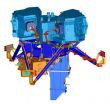(Press-News.org) CORVALLIS, Ore. – Faster development of the promising field of cellulosic biofuels – the renewable energy produced from grasses and trees – is being significantly hampered by a "deep and thorny regulatory thicket" that makes almost impossible the use of advanced gene modification methods, researchers say.
In a new study published today in the journal BioScience, scientists argue that major regulatory reforms and possibly new laws are needed to allow cellulosic bioenergy to reach its true potential as a form of renewable energy, and in some cases help reduce greenhouse gas emissions that cause global warming.
"It's extraordinary that gene modification technology, which has been adapted more rapidly than any other technology in the history of agriculture, and had some profound environmental and economic benefits, has been regulated virtually out of existence for perennial cellulosic biofuels crops," said Steve Strauss, a distinguished professor of forest biotechnology at Oregon State University, and lead author of the paper.
In the report, the authors noted that exotic plant species pose a serious risk of spread and ecosystem impacts, but face much less stringent regulation or obstacles than genetically engineered crops, which are carefully designed to solve problems, not cause them.
A genetically modified plant in which one or a few genes have been changed is treated as more of a risk than an invasive species that has thousands of new genes, and as a result is often resistant to multiple pests and has novel adaptive traits such as drought and heat tolerance, they said.
Companies that have the technical expertise to conduct advanced research have been forced to stay away from gene modification methods, rather than adopt them to speed breeding progress and insert novel traits important to the growing biofuels industry.
Traits that could be improved with gene modification include enhanced stress tolerance, reduced costs of conversion to liquid fuels, reduced use of water and fertilizer in cultivation, avoiding dispersal into the environment, and synthesis of new, renewable products such as industrial enzymes.
But virtually none of that potential is now being developed, they said.
The current environment poses enormous legal risks that can and have cost some companies millions of dollars in civil lawsuits, the scientists said, sometimes for damages that were more of perception and market issues, than of safety or environmental impact.
"Even research on traits expressly intended to reduce environmental impacts face the same legal risks and regulatory barriers as other traits," Strauss said. "Our own federally-funded research on means to promote ecological containment of gene-modified and exotic biofuel crops has been brought to a standstill by regulations."
The scientists said that the end result of a gene modification project – the trait produced, and whether it is safe and beneficial or not – should be the primary consideration for regulation, not the process used to produce it. Low-level risk and high benefit projects should be identified and allowed to move forward with much less stringent regulation or none at all. They also made several other suggestions for reform to make the overall system less slow, costly and uncertain.
"It is essential that we create an intelligent regulatory system that does not indiscriminately penalize the gene modification process and obstruct essential field research," Strauss said. "The one-size-fits-all style system of today treats the process of genetic modification as inherently dangerous, although many high-level science panels have concluded that the process is at least as safe as conventional breeding methods."
In some cases, the stringent regulations make it virtually impossible to do the very research needed to adequately understand issues of value and safety, the researchers said.
"The regulations in place, forthcoming, and those that have been imposed by legal actions result in the presumption that all forms of gene modified trees and grasses are 'plant pests' or 'noxious weeds' until extensive experimentation and associated documentation 'prove' otherwise," the scientists wrote in their report.
Solving these problems will require new ways of thinking and strong scientific and political leadership to create a regulatory system that enables, rather than arbitrarily blocks, the use of gene modification as a tool to accelerate and diversify the breeding of perennial biofuel crops, the researchers concluded.
###
Editor's Note: Strauss is in transit from international travel from Oct. 1-3, but will try to respond to email inquiries as possible. He will be available at the listed phone and email contacts on and after Oct. 4.
END
BUFFALO, N.Y. -- Biomedical researchers at the University at Buffalo have engineered adult stem cells that scientists can grow continuously in culture, a discovery that could speed development of cost-effective treatments for diseases including heart disease, diabetes, immune disorders and neurodegenerative diseases.
UB scientists created the new cell lines – named "MSC Universal" – by genetically altering mesenchymal stem cells, which are found in bone marrow and can differentiate into cell types including bone, cartilage, muscle, fat, and beta-pancreatic islet cells. ...
ROCHESTER, Minn. -- In a review article published in the October issue of Mayo Clinic Proceedings,(http://www.mayoclinicproceedings.com) Mayo Clinic physicians differentiate the ethical and legal permissibility of withholding or withdrawing life-sustaining treatments and accepted comfort measures, specifically palliative sedation, from that of physician-assisted suicide or euthanasia.
Physician reviewers find that palliative sedation has an important place on the continuum of appropriate palliative care. "At the end of life, patient goals often shift to comfort, and removal ...
What does it take to save a species in the 21st century? The specter of climate change, with predicted losses to biodiversity as high as 35 percent, has some scientists and managers considering taking their conservation strategies on the road.
Managed relocation (MR) is literally the physical relocation of endangered or threatened species of plants and animals, by humans, to new, and foreign geographical climes. It addresses the concern that climate shifts may make many species' historical ranges environmentally inhospitable, and that the rapid speed of change and habitat ...
In a "marriage" that U.S. east coast residents would object to, the remnants of Tropical Storm Nicole coupled with an upper level low pressure area have dumped record rainfall from the Carolinas to New England on Sept. 30. The GOES-13 Satellite captured that massive "union" of a system as it begins to push off the northeastern U.S. coast today, Oct. 1.
At 1401 UTC (10:01 a.m. EDT) on Oct. 1, the Geostationary Operational Environmental Satellite called GOES-13 captured a visible image of the extensive cloud cover of this coupled system. The GOES image shows the system's ...
A major instrument due to fly aboard NASA's James Webb Space Telescope is getting its first taste of space in the test facilities at the Rutherford Appleton Laboratory (RAL) in the United Kingdom. The Mid-InfraRed Instrument (MIRI) has been designed to contribute to areas of investigation as diverse as the first light in the early Universe and the formation of planets around other stars.
"The start of space simulation testing of the MIRI is the last major engineering activity needed to enable its delivery to NASA. It represents the culmination of 8 years of work by the ...
The use of computer-aided detection (CAD) is increasing, in both screening and diagnostic mammography, according to a study in the October issue of the Journal of the American College of Radiology (www.jacr.org). CAD software systems highlight and alert the radiologist of abnormal areas of density, mass or calcification on a digitized mammographic image (of the breast) that may indicate the presence of cancer.
Screening mammography is an X-ray exam of the breast that is used as a screening tool to detect early breast cancer in women experiencing no symptoms. Diagnostic ...
Researchers working in a radiology department at a mid-sized hospital were able to increase productivity and improve efficiency by developing a simple method for measuring general technologist productivity, according to a study in the October issue of the Journal of the American College of Radiology (www.jacr.org).
"Improving productivity and maintaining team spirit are often competing priorities that may be difficult to achieve simultaneously," said C. Daniel Johnson, MD, co-author of the study. "In an era of cost reductions, radiology departments need to be able to ...
Boulder, CO, USA - This month's themed issue, "Advances in 3D imaging and analysis of geomaterials," edited by Guilherme A.R. Gualda, Don R. Baker, and Margherita Polacci, features papers from the 2009 AGU Joint Assembly session "Advances in 3-D Imaging and Analysis of Rocks and Other Earth Materials." Studies include 3-D imaging and analysis techniques for Wild 2 comet material returned from the NASA Stardust mission and the first 3-D X-ray scans of crystals from the Dry Valleys, Antarctica.
Introduction: Advances in 3D imaging and analysis of geomaterials
Guilherme ...
Reston, Va.— Research reported in the October issue of The Journal of Nuclear Medicine (JNM) shows that a molecular imaging technique may prove useful in early assessment of treatment response for cisplatin-resistant ovarian cancer.
"One of the most promising aspects of molecular imaging is its potential capacity to measure therapy effects long before changes in the tumor size and shape are detected," said Marijke De Saint-Hubert, medical scientist in the Department of Nuclear Medicine at the University Hospital Gasthuisberg, Leuven, Belgium, and one of the authors on ...
Johns Hopkins scientists have discovered that the over-activation of a single protein may shut down the brain-protecting effects of a molecule and facilitate the most common form of Parkinson's disease. The finding of this mechanism could lead to important new targets for drugs already known to inhibit it, thus controlling symptoms of the disorder, which affects about 1 million older Americans.
Previous research demonstrated that a protein called parkin protects brain cells by "tagging" certain toxic elements that are then destroyed naturally. It was also known that ...


